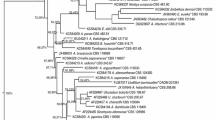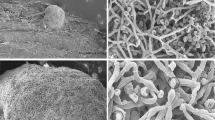Abstract
Forty-one isolates ofFusarium sambucinum sensu lato were screened for production of secondary metabolites in agar cultures. Of 16 strains ofF. sambucinum sensu stricto all but two strains produced diacetoxyscirpenol and two unidentified metabolites, TB1 and TB2 respectively. The two remainingF. sambucinum strains produced T-2 toxin, TB1 and TB2.Fusarium venenotum (6 strains) produced diacetoxyscirpenol and an unidentified metabolite BB.Fusarium torulosum (8 strains) produced wortmannin and antibiotic Y. The three species could be differentiated by their pattern of identified and unidentified metabolites detected by agar plug TLC combined with chemical data from HPLC-diode array detection of fungal extracts, and data on growth rates on potato sucrose agar and tannin sucrose agar.
Similar content being viewed by others
References
Marasas WFO, Nelson PE, Toussoun TA. ToxigenicFusarium species: Identity and mycotoxicology. University Park London: The Pennsylvania State University Press, 1984.
Thrane U.Fusarium species and their specific profiles of secondary metabolites. In: Chelkowski J, ed.Fusarium: Mycotoxins, taxonomy and pathogenicity. Amsterdam: Elsevier, 1989: 199–225.
Beremand MN, Desjardins AE, Hohn TM, VanMiddlesworth FL. Survey ofFusarium sambucinum (Gibberella pulicaris) for mating type, trichothecene production, and other selected traits. Phytopathology 1991; 81: 1452–58.
Desjardins AE, Beremand MN. A genetic system for trichothecene toxin production inGibberella pulicaris (Fusarium sambucinum). Phytopathology 1987; 77: 678–83.
Desjardins AE, Plattner RD. Trichothecene toxin production by strains ofGibberella pulicaris (Fusarium sambucinum) in liquid culture and in potato tubers. J Agric Food Chem 1989; 37: 388–92.
Beremand MN, Desjardins AE. Trichothecene biosynthesis inGibberella pulicaris: Inheritance of C-8 hydroxylation. J Ind Microbiol 1988; 3: 167–74.
Sanson DR, Corley DG, Barnes CL, Searles S, Schlemper EO, Tempesta MS, Rottinghaus GE. New mycotoxins fromFusarium sambucinum. J Org Chem 1989; 54: 4313–18.
Perkowski J, Foremska E, Latus-Zietkiewicz D. The yields of diacetoxyscirpenol produced byFusarium sambucinum cultures isolated from potato tubers and their toxicity to brine shrimps (Artemia salina). Mycotoxin Res 1989; 5: 61–67.
Bosch U, Mirocha CJ, Abbas HK, di Menna M. Toxicity and toxin production byFusarium isolates from New Zealand. Mycopathologia 1989; 108: 73–79.
Abbas HK, Mirocha CJ, Gunther R. Production of zearalenone, nivalenol, moniliformin, and wortmannin from toxigenic cultures ofFusarium obtained from pasture soil samples collected in New Zealand. Mycotoxin Res 1991; 7: 53–60.
Abbas HK, Mirocha CJ, Gunther R. Mycotoxins produced by toxicFusarium isolates obtained from agricultural and nonagricultural areas (Arctic) of Norway. Mycopathologia 1989; 105: 143–51.
Farber JM, Sanders GW. Production of fusarin C byFusarium spp. J Agric Food Chem 1986; 34: 963–66.
Nirenberg H. Morphological differentiation ofFusarium sambucinum Fuckel sensu stricto,F. torulosum (Berk & Curt.) Nirenberg comb. nov. andF. venetatum Nirenberg sp. nov. Mycopathologia 1995; 129: 131–141 (this issue).
Thrane U. FUSKEY, an interactive computer key to commonFusarium species. Mycotoxin Res 1991; 7A: 50–53.
Nirenberg H. Untersuchungen über die morphologische und biologische Differenzierung in derFusarium-SektionLiseola. Mitt Biol Bundesanst Land- u Forstw (Berlin-Dahlem) 1976; 169: 1–117.
Booth C. The genusFusarium. New (UK): Commonwealth Mycological Institute, 1971.
Thrane U. Detection of toxigenicFusarium isolates by thin layer chromatography. Lett Appl Microbiol 1986; 3: 93–96.
Thrane U. The ability of commonFusarium species to grow on tannin-sucrose agar. Lett Appl Microbiol 1986; 2: 33–35.
Frisvad JC. Physiological criteria and mycotoxin production as aids in identification of common asymmetric penicillia. Appl Environ Microbiol 1981; 41: 568–79.
Filtenborg O, Frisvad JC, Thrane U. The significance of yeast extract composition on metabolite production inPenicillium. In: Samson RA, Pitt JI, eds. Modern concepts inPenicillium andAspergillus classification. New York: Plenum Press, 1990: 433–441.
Frisvad JC, Filtenborg O. Classification of terverticillate Penicillia based on profiles of mycotoxins and other secondary metabolites. Appl Environ Microbiol 1983; 46: 1301–10.
Frisvad JC, Thrane U. Standardized high-performance liquid chromatography of 182 mycotoxins and other fungal metabolites based on alkylphenone indices and UV-VIS spectra (diode-array detection). J Chromatogr 1987; 404: 195–214.
Thrane U. Screening for fusarin C production by European isolates ofFusarium species. Mycotoxin Res 1988; 4: 2–10.
Frisvad JC. The use of high-performance liquid chromatography and diode array detection in fungal chemotaxonomy based on profiles of secondary metabolites. Bot J Linn Soc 1989; 99: 81–95.
Abbas HK, Mirocha CJ. Isolation and purification of a hemorrhagic factor (wortmannin) fromFusarium oxysporum (N17B). Appl Environ Microbiol 1988; 54: 1268–74.
Gunter R, Abbas HK, Mirocha CJ. Acute pathological effects on rats of orally administered wortmannin-containing preparations and purified wortmannin fromFusarium oxysporum. Fd Chem Toxic 1989; 27: 173–79.
Lund F, Thrane U, Frisvad JC, Filtenborg O. IBT List of fungal cultures and their secondary metabolites. Lyngby: Instituttet for Bioteknologi, DTH, 1992.
Gerlach W, Nirenberg H. The genusFusarium: A pictorial atlas. Mitt Biol Bundesanst Land- u Forstw (Berlin-Dahlem) 1982; 209: 1–406.
Burnett JH. Aspects ofFusarium genetics. In: Moss MO, Smith JE, eds. The applied mycology ofFusarium. Cambridge: Cambridge University Press, 1984: 39–69.
Duncan JS, Bu'Lock JD. Degeneration of zearalenone production inFusarium graminearum. Exp Mycol 1985; 9: 133–40.
Bushnell GW, Li Y-L, Poulton GA. Pyrones X: Lateropyrone, a new antibiotic from the fungusFusarium lateritium Nees. Can J Chem 1984; 62: 2101–6.
Gorst-Allman CP, Rooyen PH, Wnuk S, Golinski P, Chelkowski J. Structural elucidation of an antibiotic from the fungusFusarium avenaceum Fries Sacc.: An amended structure for lateropyrone. S Afr J Chem 1986; 39: 116–117.
Golinski P, Wnuk S, Chelkowski J, Visconti A, Schollenberger M. Antibiotic Y: Biosynthesis byFusarium avenaceum (Corda ex Fries) Sacc., isolation, and some physiochemical and biological properties. Appl Environ Microbiol 1986; 51: 743–45.
Hashmi MH, Thrane U. Mycotoxins and other secondary metabolites in species ofFusarium isolated from seeds of capsicum, coriander and fenugreek. Pak J Bot 1990; 22: 106–116.
Hawksworth DL. Mycologist's handbook. Kew (UK): Commonwealth Mycological Institute, 1974.
Author information
Authors and Affiliations
Corresponding author
Rights and permissions
About this article
Cite this article
Thrane, U., Hansen, U. Chemical and physiological characterization of taxa in theFusarium sambucinum complex. Mycopathologia 129, 183–190 (1995). https://doi.org/10.1007/BF01103345
Received:
Accepted:
Issue Date:
DOI: https://doi.org/10.1007/BF01103345




